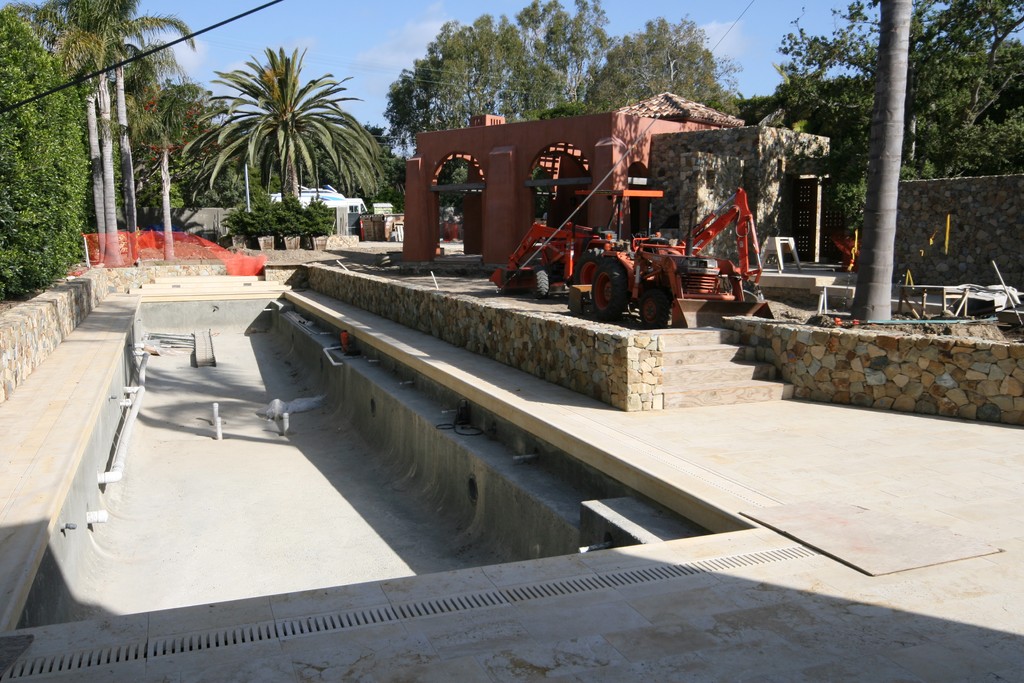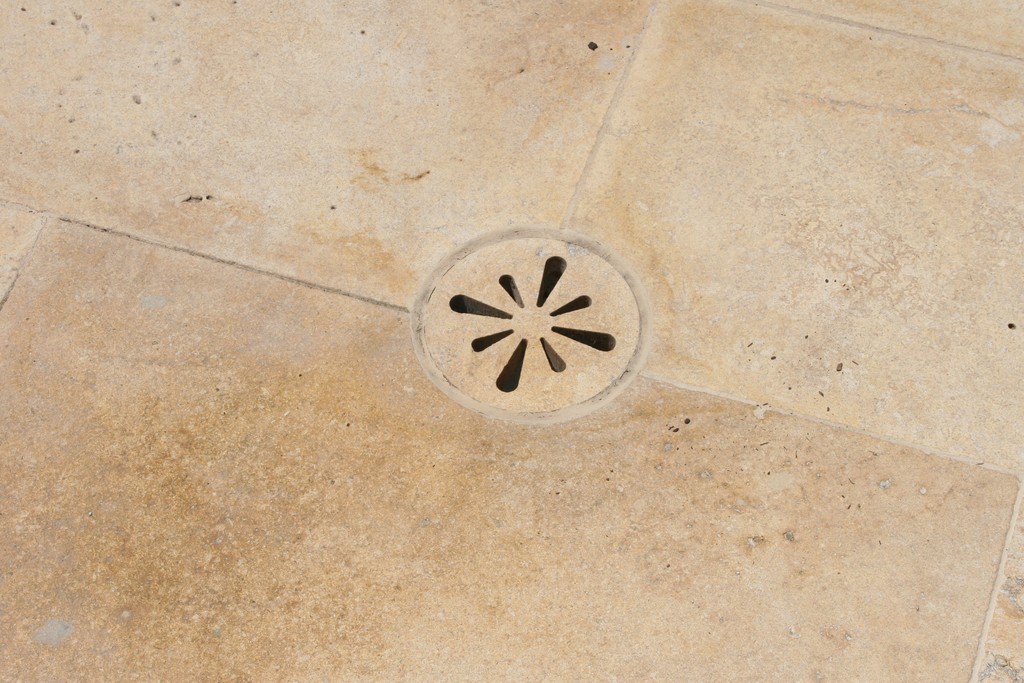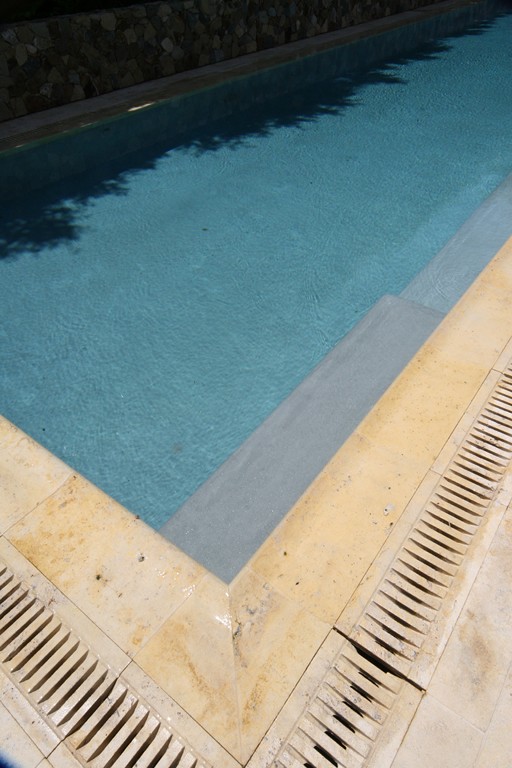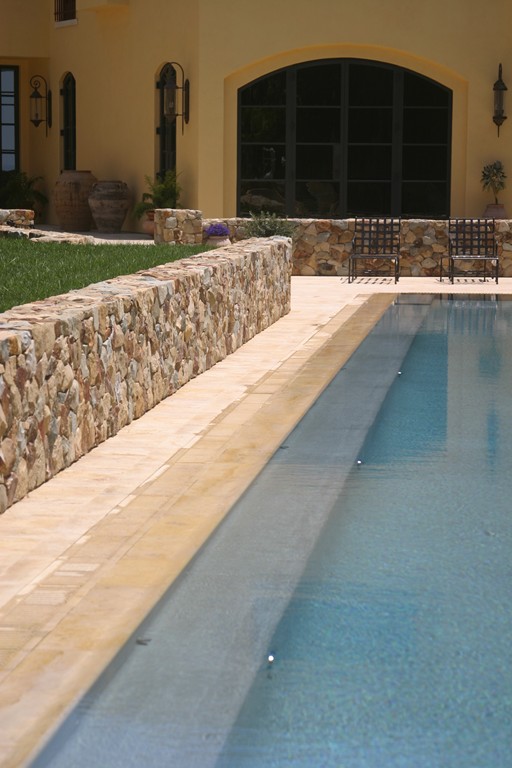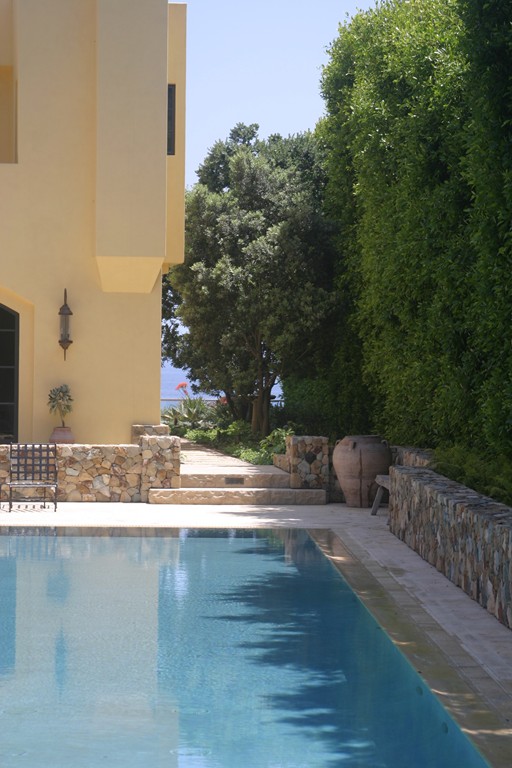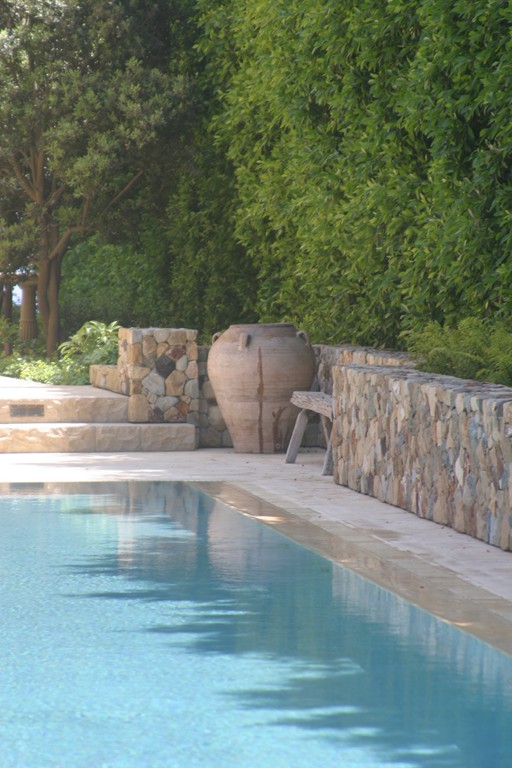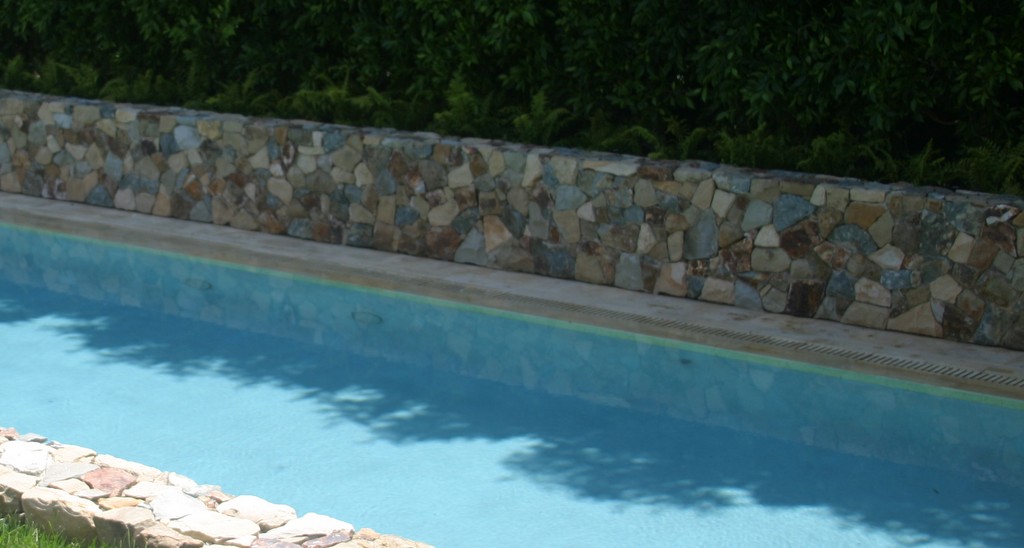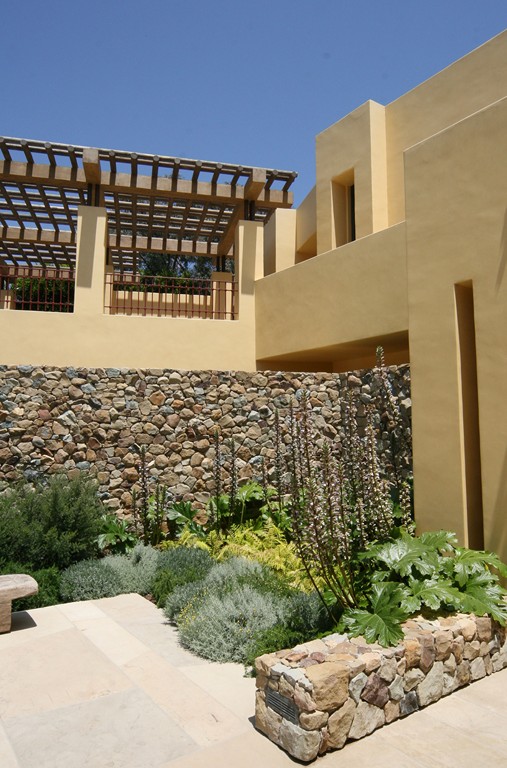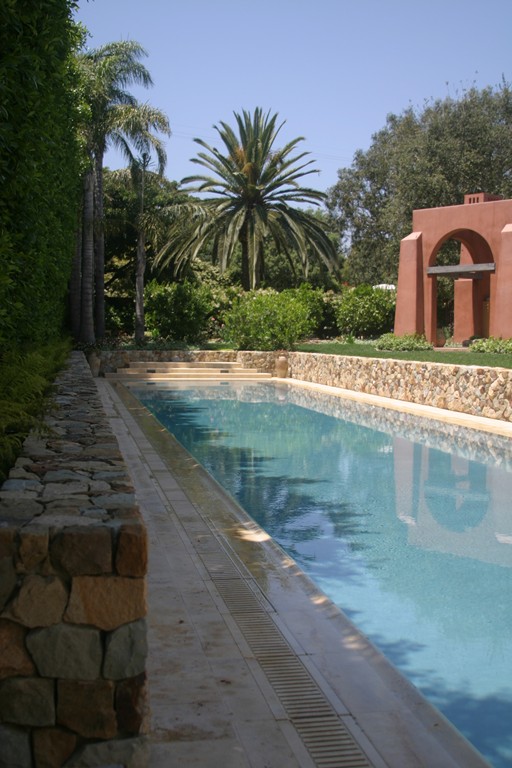Linear Grace
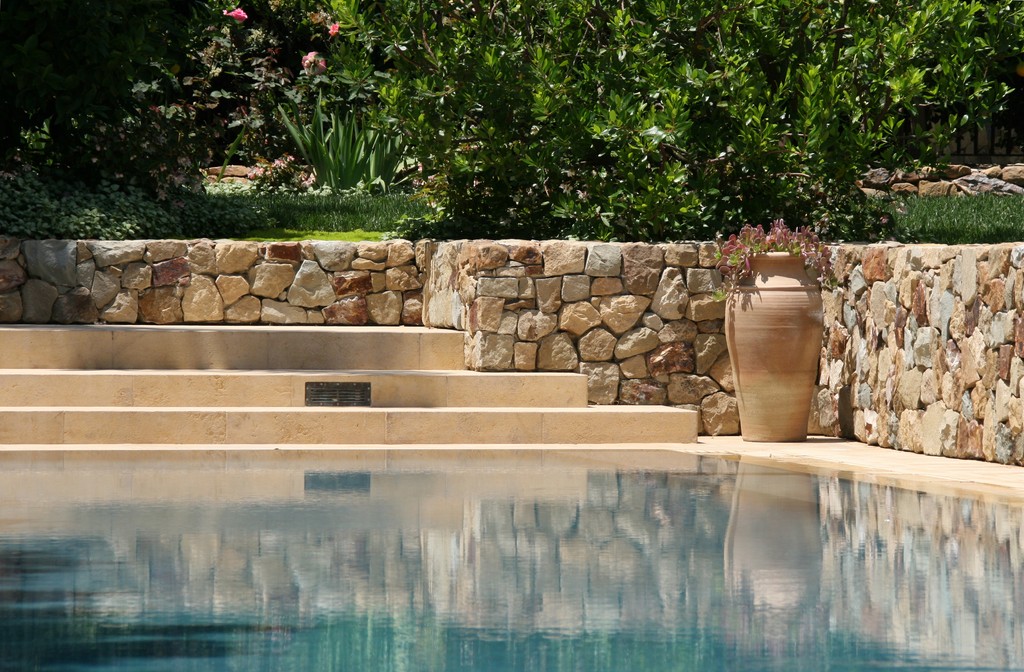
As a rule, I avoid working for contractors: I’ve found that far too many of them spend so much time worrying about the bottom line that they lose sight of the fact that their clients want quality rather than compromises. I’ve also found that their general caution is often at its worst when it comes to watershapes: Even though these structures may be key components of the overall project, they tend to come along late in the process and are all too often seen as places where corners can be cut to meet overall budget goals.
Frankly, I’ve never liked being treated as a pawn or second-class citizen, so I avoid these situations like the plague. Instead, I typically work directly for homeowners and refuse to subordinate my part of a project to the whims of another contractor.
Any worthwhile rule, however, has its exceptions – and in my case one of them is working with Greg Golenberg of Golenberg & Company Construction (Agoura Hills, Calif.): He’s among the finest builders I’ve ever known, and I’m proud of having worked for him on a number of projects through the years.
In the case on display here, he introduced me to clients who wanted only the best of everything, from the design of the house down to the smallest detail of the exteriors and landscape. And it was easy to understand why: The house sits on a bluff directly overlooking the Pacific Ocean in Malibu – one of the most beautiful locations for a home I’ve ever seen.
When Golenberg called and asked me to design and build the swimming pool, I jumped at the chance to join the project team. Not only did I know this would be a chance to create something truly special, but I also recognize the fact that Greg firmly believes in gathering whole families of top-notch professionals for his projects.
DOWN TO DETAILS
Golenberg’s secret? He’s a master of the lost art of listening, and in this case the team produced in ways that offer eloquent testimony to the value of his enlightened approach.
From the very start, every aspect of this project was about its details. The house itself is a masterful blend of Moroccan Revival and Modernist forms, with everything from the lighting fixtures and railings to the faucets and stonework thought out in painstaking detail. The color palette is reminiscent of those deployed by Luis Barragan or Ricardo Legorreta, while the architecture is boxy in a way that recalls Le Corbusier.
| This perimeter-overflow system is different from most in that the water exits the overflow gutter through the side rather than flowing straight down. This keeps air from being drawn into the system, thereby eliminating gurgling sounds and making pool operation about as quiet as it can be. |
Whatever the visual references were to great architects, however, the overall linearity was to be softened by plantings and landscape choices – and through extensive use of stone around the pool and on prominent walls.
In keeping with this architectural program, the pool was designed for simple elegance. At 80 feet long and ten feet wide, it’s a starkly rectangular, perimeter-overflow lap pool flanked by retaining walls done up with Santa Barbara Gold cladding
that run the length of vessel and enclose a narrow, slightly recessed deck area.
The pool is center deep, starting at a four-foot depth at both ends and moving gradually to a center depth of five feet. As I’ve suggested before on many occasions, there’s no reason to go deeper unless a client specifically enjoys diving or likes to tread water. In this case, the homeowner is an ardent swimmer who wanted an Olympic-style overflow system to minimize wave action off the wall. (Most of the time, clients view a perimeter-overflow as a visual detail, but here it was included in the design as a practical matter.)
| Once the shell was ready (complete with its long interior bench), we installed the drain grates and then waited for the rest of the work on site to approach completion before applying our finishing touches. |
To get started, I asked for a soils-and-geology report – something I require for every project without exception. As I’ve stated in these pages countless times and will repeat as often as I can, all construction depends entirely on the nature of the soil upon which a project is to be built, and that goes for bridges, skyscrapers and houses as well as watershapes. So even though I’d been assured that we were all working in “competent” soil, I’d had enough experience in Malibu to know I needed the very specific information that only comes with complete testing, including test pits.
What’s true in one spot may be completely different just a few feet away, and that was the case here: At one end of the pool, they found competent, load-bearing soil three feet below grade, but on the other end, it was nine feet down. With this information in hand along with my plans, I went to see my longtime associate, Mark Smith of Mark L. Smith Architecture & Engineering (Tarzana, Calif.).
Smith prepares all of my architectural and structural-engineering details, and he and I determined that the pool would best be supported by installing a deepened foundation that would span approximately three quarters of the structure’s length.
Following this program, we over-excavated one end of the pool by about seven feet, set up a system of #4 rebar on 18-inch centers three ways (horizontally, vertically and longitudinally), then pumped in 3,000 psi-plus concrete as a foundation. With the shell placed atop this structure, there would be no possibility of differential settlement – the main cause of shell failures here in California and elsewhere.
IN THE GUTTER
As mentioned above, the overflow detail was critical from a functional standpoint, but we also focused on the visuals for obvious reasons. I knew I had to be unusually careful in this case, however, because most perimeter-overflow systems lend their projects a distinctly contemporary look that wouldn’t harmonize with the mostly Moroccan inclinations of the setting and our general desire to use the exterior spaces to soften the hard edges of the architecture.
With a solution in mind, I called Tim and Steve Harris of Harris Brothers Natural Stone Imports (Monterey, Calif.) and asked them if they could get me enough of a Greek limestone known as Kapandriti to get the job done. (For more information, see the sidebar at right.) What I needed, I said, was a bullnose coping with a very slightly raised profile that would allow water to flow easily over the edge and into a series of incised stone grates made from the same material.
Despite the contemporary nature of the perimeter-overflow approach, even when the water is running over the coping and into the gutter, this pool still boasts a relatively traditional appearance. In fact, it’s almost a retro look that fully supports the visual environment rather than making a noticeable artistic statement on its own.
This left me, of course, with the challenge of building a system to collect the water that would pass through the grates and ultimately flow to the surge tank. Personally, I’ve never been satisfied with the approach almost everyone who works with perimeter overflows use – that is, where the pick-ups feeding the trunk lines are mounted vertically and drop to a trunk line placed directly below the gutter: It may be easier to build them this way, but I dislike the loud gurgling noises that commonly result from this approach because of the way air is drawn into the system along with the water.
| In entering the property from the street, you move along a curving path through a lushly planted space and eventually see the house rising above the long, highly reflective pool surface. The stone details unify the space, leading the eye on one side of the pool toward the front entry and on the other side to access to a gap that leads out to a bluff overlooking the Pacific Ocean. |
If water only makes these noises when it falls vertically, then why not have it flow horizontally instead? This is why I developed a plumbing detail in which the lines exiting the gutter are plumbed laterally from the sides of the gutter – in this case with three-inch pick-up lines placed every four feet to feed a six-inch trunk line that stands on its own outside the gutter.
All we did was pitch the floor of the gutter about an eighth of an inch toward the openings of the lines, which are mounted a quarter inch below the floor of the gutter. This way, the water always flows directly and gently into the pick-up lines, which are themselves slightly pitched down to the trunk lines to ensure easy flow.
| It pays to be observant as you move through these spaces: There are so many nice touches, well-composed vignettes, wonderful elevation changes, amazing colors and textures and well-managed transitions that anyone with an eye out for visual beauty and drama will be richly rewarded. |
The pool is quite long, so to ensure adequate pitching of the trunk lines, we broke the system into three separate sections, each with high points on center. The idea is that all parts of the system work by gravity, silently clearing the gutter the instant water flows into it.
The grates were another consideration in our noise-reduction campaign: Although there’s still some noise as water flows through the grates and drops into the gutter, the sound is minimal. And when you consider that we’ve basically eliminated the noise associated with the water leaving the gutter, the overall system is remarkably quiet.
We also reduced a source of visual noise by coating the inside of the gutter with a black-oxide vinyl material: When you look down at the grates, all you see is a void or, when the sun is high in the sky, fleeting shadows cast by the grates.
IN THE SIDE
Another significant detail is inside the pool, in the form of the bench that runs along its full length. I’ve been using this detail for almost 30 years now, and my clients love these structures because they serve not only as steps down into the water, but also function as seating areas. In this particular case, the bench has the added benefit of offering easy entry and egress points along the entire 80-foot length of the pool.
We made great additional use of this detail by mounting all the lights in it, positioned so they face away from the house. We also placed all of the return outlets on the bench’s face, doing everything we possibly could to avoid visual disruptions in the pool’s long expanse of floor.
| All through the space, there’s a sense of gracious elegance and of spaces made for comfort, social ease and family fun. The low-slung pool and its rich reflections are subtle components of the overall setting – understated companions to the project’s engaging architecture, gorgeous landscaping and beautiful stonework. |
Too often, builders have so much happening on floors that it looks as though the pool has come down with a nasty case of permanent chicken pox. What I prefer to do is leave these flat, basically horizontal spaces as clear of visual obstructions as possible – and, with any penetrations I can’t avoid, do all I can to hide them by using covers that can be topped with the same material used to finish the pool’s interior.
In this case, the finish is a soft gray plaster that offers a wonderfully uniform appearance and great reflective qualities. I give credit here to my longtime friend and colleague Tony Marquez of Marquez Pool Plastering (Sun Valley, Calif.): His crews do an amazing job, and their attention to details such as the radii on the bench system was much appreciated. (It bears mentioning that plastering a rectilinear pool of this size while holding all of those long lines is surprisingly difficult.)
The result for the watershape is a beautifully uniform appearance, brilliant reflective qualities and a vessel that, as intended from the start, serves to enhance the setting rather than draw attention to itself. As for the overall project and the team’s collective effort, well, the proof is in the pictures.
David Tisherman is the principal in two design/construction firms: David Tisherman’s Visuals in Manhattan Beach, Calif., and Liquid Design of Cherry Hill, N.J. A designer and builder of custom, high-end swimming pools since 1979, he is widely known in the pool and spa industry as an advocate for the highest possible standards of design, engineering and construction. He has degrees and credentials in industrial design, scientific illustration and architectural drawing from Harvard University and Art Center College of Design and has taught architectural rendering and presentation at UCLA. An award-winning designer, he serves as an industry expert for California’s Contractor State License Board and was also a 2008 recipient of The Joseph McCloskey Prize for Outstanding Achievement in the Art & Craft of Watershaping.














